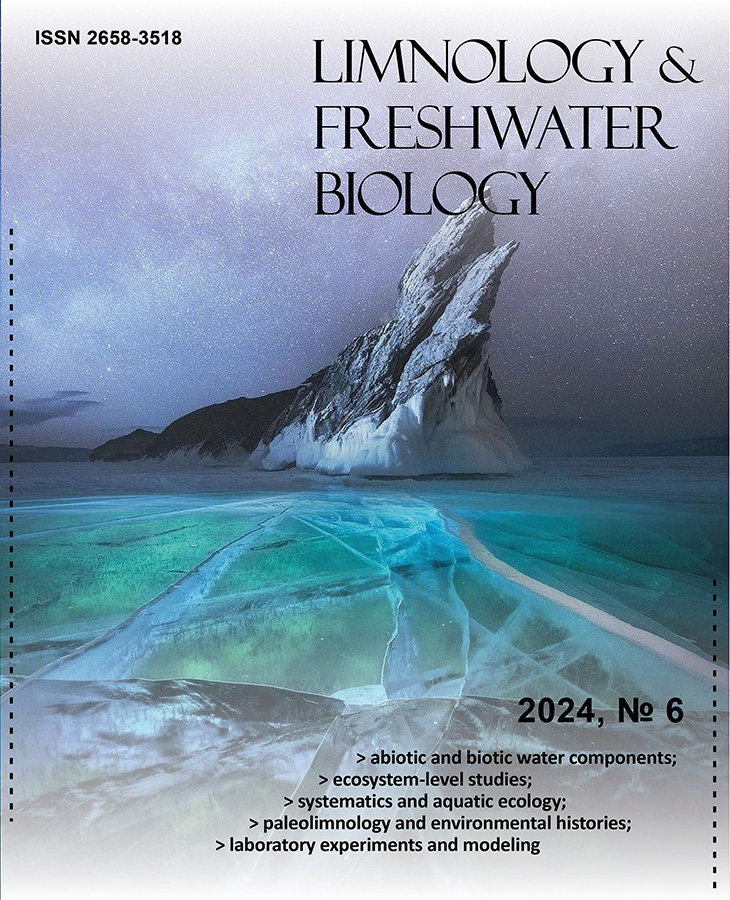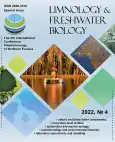Natural and anthropogenic impact on the biodiversity of malacofauna of the Caspian Sea
- Authors: Yanina T.A.1
-
Affiliations:
- Saint Petersburg State University
- Issue: No 4 (2022)
- Pages: 1610-1611
- Section: Articles
- URL: https://journal-vniispk.ru/2658-3518/article/view/288363
- DOI: https://doi.org/10.31951/2658-3518-2022-A-4-1610
- ID: 288363
Cite item
Full Text
Abstract
Generation of biodiversity during the Neopleistocene and the Holocene was determined by the parameters of aquatic environment of basins (the sea-level mode, temperature, salinity), mainly reflecting climatic changes. The anthropogenic factor contributes essentially to the structure of the biodiversity. This paper aimed to show the impact of natural and anthropogenic factors on the generation of the mollusk’s biodiversity. The material for research was the analysis of the long-term field works of the author on the coasts of the Caspian Sea and the studying of the core of sea boreholes. It is cocluded that over the last 6 thousand years, invasive and acclimatized species made much more significant changes in biodiversity than those caused by natural factors. Natural ecosystems have undergone the anthropogenic transformation. Over the course of historical time, there has been not only fast change in biodiversity, but also irreversible change in aquatic ecosystems. The role of the anthropogenic factor on the species distribution in the basin became the major.
Full Text
Introduction
Malacofauna is an important component of the Caspian Sea ecosystem. Mollusks are sensitive to changes in the physical, geographical and hydrological conditions of the basin and serve as an important indicator of changes in the natural environment. Generation of biodiversity during the Neopleistocene and the Holocene was determined by the parameters of aquatic environment of basins (the sea-level mode, temperature, salinity), mainly reflecting climatic changes. The anthropogenic factor contributes essentially to the structure of the biodiversity. This paper aimed is to show the impact of natural and anthropogenic factors on the generation of the mollusk’s biodiversity.
Materials and methods
The material for research was the analysis of the long-term field works of the author on the coasts of the Caspian Sea and the studying of the core of sea boreholes. The main method is malakofaunistic, including the study of taxonomic composition, taphonomy, biostratigraphic distribution, historical development, phylogeny, mollusk biogeography.
Results and discussion
The composition of modern mollusks is the result of evolutionary processes in the Pleistocene fauna that occurred under conditions of climatic changes and transgressive-regressive rhythm of the Caspian Sea. In the recent (Neopleistocene and Holocene) history of the sea, the development of six transgressive basins was reconstructed: Baku, Urundzhik, Early Khazar, Late Khazar, Khvalynian and Novocaspian complicated in turn by stages, phases and oscillations. They are all separated by the epochs of regressive basins. Each basin had unique environment. For most of the Neopleistocene, the Caspian was a drainageless water body. The flow into the Pontian basins along the Manych Strait was observed there for 5 times. (Popov, 1983; Yanina, 2012). The inflow of the Black Sea waters into the Caspian Sea was not recorded. In the epochs of large transgressions, the Caspian area increased 2.5 times compared to the modern one, and the level increased to +50 m. During regressions, the Caspian level dropped to –100 m abs. The Caspian Sea was a brackish-water basin with relatively small fluctuations in salinity (no more than 6-7 ‰) during the Neopleistocene. As for temperature, cold and warm transgressions were released (Yanina, 2012; 2013). Malacofauna relates to the abundance of endemic cardiid and dreissenid bivalve species (of the genera Didacna, Monodacna, Adacna, Hypanis and Dreissena). Malakofaunistic analysis of the Neopleistocene sediments (Yanina, 2012) showed that despite the transgressive-regressive rhythm of the Caspian Sea of significant amplitude, the generic composition of mollusks remained unchanged.
In the Holocene, the marine species Cerastoderma glaucum is widely distributed. Malakofaunistic studies of the Holocene deposits of the Caspian region (Svitoch and Yanina, 1997; Yanina, 2012; Vande Velde et al., 2019) showed the first appearance of this species in the sediments of the Novocaspian transgression and its gradual spread and increase in abundance. There is no convincing evidence for the penetration of the species from the Black Sea into the Caspian Sea. There is no evidence of the functioning of the Manych Strait between the Pontus and the Caspian in the post-Khvalynian epoch. The author of the paper is inclined to assume that C. glaucum penetrated during the epoch of maximum of the Novochernomorsk transgression of Pontus when there was a sea bay inhabited by these mollusks in the West Manych Valley. A number of residual saline lakes existed in the Manych Depression. From the sea bay through the chain of lakes with the help of an ancient man (who used to eat these mollusks), this eurybiont species got into the Novocaspian basin. One way of its penetration is aquatic.
Thus, the penetration of a marine species into the Caspian was connected with an anthropogenic factor already in the first half of the Holocene. Its influence on the Caspian fauna was significant. All facies of the Novocaspian deposits of the Turali section (Dagestan coast) contain shells of this species (Vande Velde et al., 2019). Thus, the biodiversity structure of the Novocaspian basin has changed: there has been an increase in the number of taxa due to the biological invasion of the Mediterranean specie C. glaucum. Significant changes occurred in the quantitative distribution of taxa: a gradual increase in the number of C. glaucum and a decrease in Caspian endemics of the cardiid family.
The modern epoch is distinguished by the development of two more marine species - Mytilaster lineatus and Abra segmentum. The first was entered into the Caspian Sea by chance during the transfer of ships from the Black Sea basin during the Civil War at the beginning of the 20th century. It was firstly recorded in the Caspian in 1928 (Abdurakhmanov et al., 2002). Because of similarity with Dreissena in substrate requirements, the emergence of Mytilaster led to the extinction of Dr. caspia and the pushing of Dr. andrusovi into areas with reduced salinity not available to competitors. Mollusk A. segmentum was acclimatized in the Caspian in 1947 in order to improve the food supply of sturgeon fish. Currently, bottom biocenoses is often dominated by A. segmentum, M. lineatus, C. glaucum (Abdurakhmanov et al., 2002; Yanina, 2012; Vande Velde et al., 2019), all of which are of the Mediterranean origin.
Conclusions
The Holocene complexes, unlike Neopleistocene complexes, whose change over time is caused by a change in the conditions of the aquatic environment, reflect a change in the biotic conditions of the basin - the introduction of the Black Sea species. Invasive and acclimatizing species have made greater changes in the biodiversity patterns than were caused by natural factors. Obviously, as a result of evolutionary development from a small number of related species, Caspian autochthons became possessed the universal qualities but weak species specialization, which ensured stability and relative resistance of communities to changes in environmental factors, but made them uncompetitive for marine universes. Natural ecosystems have undergone anthropogenic transformation, and historical times have seen not only a rapid change in biodiversity, but also an irreversible change in aquatic ecosystems. Currently, the role of the anthropogenic factor has become the most important in the distribution of some mollusk species in the basin. The modern development of the Caspian malacofauna leading to an increase in the diversity of mollusks because of the emergence of new taxa leads to a biodiversity loss at the global level.
Acknowledgements
The work was supported by the Russian Science Foundation (Grant No 21-44-04401).
Conflict of interest
The authors declare no conflict of interest.
About the authors
T. A. Yanina
Saint Petersburg State University
Author for correspondence.
Email: didacna@mail.ru
Russian Federation, 7-9, Universitetskaya Emb., Saint Petersburg, 199034
References
- Abdurakhmanov G.M., Karpyuk M.I., Morozov B.N. et al. 2002. Sovremennoye sostoyaniye i faktory, opredelyayushchiye biologicheskoye i landshaftnoye raznoobraziye Volzhsko-Kaspiyskogo regiona Rossii [The current state and factors determining the biological and landscape diversity of the Volga-Caspian region of Russia]. Moscow: Nauka. (in Russian)
- Popov G.I. 1983. Pleystotsen Chernomorsko-Kaspiyskikh prolivov (stratigrafiya, korrelyatsiya, paleofaunistika, geologicheskaya istoriya) [Pleistocene of the Black Sea - Caspian Sea straits]. Moscow: Nauka. (in Russian)
- Svitoch A.A., Yanina T.A. 1997. Chetvertichnyye otlozheniya poberezhiy Kaspiyskogo morya [Quaternary deposits in the Caspian coasts]. Moscow: Rossel’khozakademiya. (in Russian)
- Vande Velde S., Wesselingh F., Yanina T. et al. 2019. Mollusk biodiversity in the late Holocene nearshore environments of the Caspian Sea: a baseline for the current biodiversity crisis. Palaeogeography, Palaeoclimatology, Palaeoecology 535: 1-40. doi: 10.1016/j.palaeo.2019.109364
- Yanina T.A. 2012. Neopleystotsen Ponto-Kaspiya: biostratigrafiya, paleogeografiya, korrelyatsiya [Neopleistocene of the Ponto-Caspian: biostratigraphy, paleogeography, correlation]. Moscow: Faculty of Geography, Moscow State University. (in Russian)
- Yanina T.A. 2013. Evolution of the environment of the Ponto-Caspian under conditions of the global climate change in the Late Pleistocene. Vestnik Moskovskogo Universiteta. Seriya 5. Geografiya [Bulletin of Moscow University. Series 5. Geography] 1: 3-16. (in Russian)
Supplementary files










